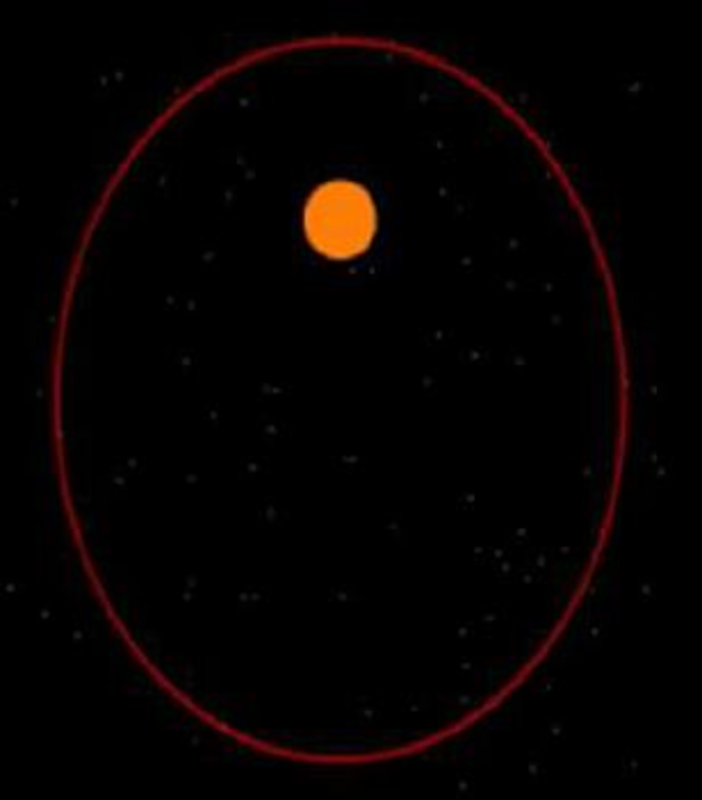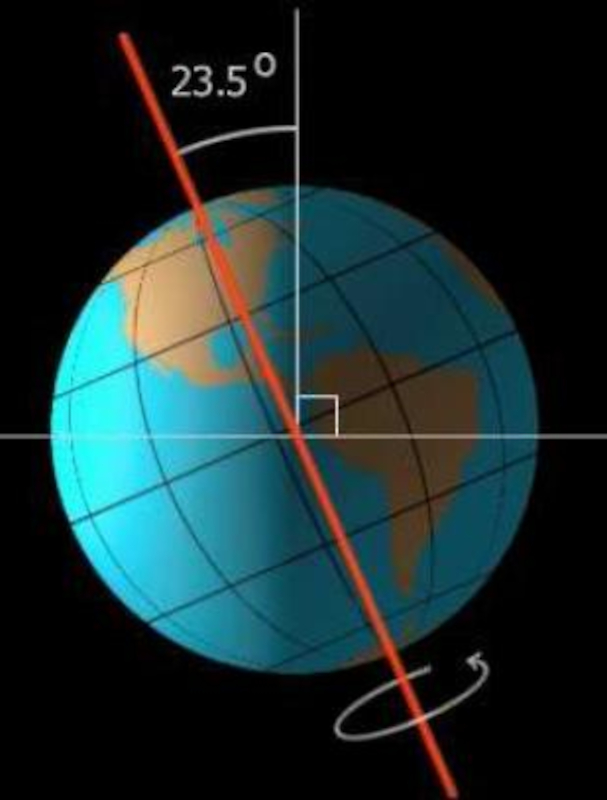Earth movement
Storyboard 
The power of the sun that finally reaches a place on the face of the earth depends on the one hand on the distance to the sun, the inclination of the axis and the rotation of the planet.
ID:(533, 0)
Elliptical orbit
Description 
The Earth's orbit forms an ellipse in which the Sun is located at one of the foci:

The plane containing the orbit is called the ecliptic.
The point farthest from the Sun is called the aphelion (July 7th), and the closest point is called the perihelion (January 3rd). The midpoints where the Earth passes through the point where the radius coincides with the semi-minor axis are known as solstices.
The radii are referred to as the major axis (a) and the minor axis (b).
The parameters of the orbit are as follows:
Parameters | Variable | Value
|:---------------|:----------|:-----------:
Major axis (Semi-major axis) | a | 149,598,000 km
Minor axis (Semi-minor axis) | b | 149,577,000 km
Aphelion | | 152.1 \times 10^6 km
Perihelion | | 147.1 \times 10^6 km
Orbital eccentricity | \epsilon | 0.0167
Period | T | 365.256 days
Average velocity | | 29,780 m/s
ID:(3079, 0)
Way to build ellipse
Description 
An ellipse can be drawn by fixing a string to two points (the foci) and extending the string to its maximum length, then drawing points around both foci with a pencil:

None
ID:(3081, 0)
Orbit coordinates
Description 
The position of the Earth is described in terms of the coordinates (x, y), with the center of the ellipse taken as the origin:

ID:(3080, 0)
Earth coordinate x
Equation 
The x coordinate of the Earth's position as a function of time t is expressed as:
ID:(4658, 0)
Earth coordinate y
Equation 
The y coordinate of the Earth's position as a function of time t is expressed as:
ID:(4659, 0)
Sun-Earth distance
Equation 
The distance between the Sun and the Earth, denoted as r, can be calculated from the square of the coordinates:
where the coordinates are:
| x=a\,\cos\left(\displaystyle\frac{2\pi t}{T}\right) |
using the formula:
| y=a\,\sin\left(\displaystyle\frac{2\pi t}{T}\right) |
thus obtaining:
In this case, a represents the major axis, b the minor axis, and T the period of the orbit.
For comparison, the average distances from the Sun to the planets are listed below:
Planet | Average Orbit Radius [km] | Orbital Period [years]
|:-----------|:---------------------------------------------:|:---------------------:
Mercury | 5.7909227E+7 | 0.2408467
Venus | 1.08209475E+8 | 0.61519726
Earth | 1.49598262E+8 | 1.0000174
Mars | 2.27943824E+8 | 1.8808476
Jupiter | 7.78340821E+8 | 11.862615
Saturn | 1.426666422E+9 | 29.447498
Uranus | 2.870658186E+9 | 84.016846
Neptune | 4.498396441E+9 | 164.79132
Source: NASA/Lunar and Planetary Institute
ID:(4660, 0)
Orbital eccentricity
Description 
Since the orbit is an ellipse, it has a degree of deformation that is measured by its eccentricity.

The values for different planets are listed below:
Planet | Eccentricity [-]
|:-----------|:------------------:|
Mercury | 0.20563593
Venus | 0.00677672
Earth | 0.01671123
Mars | 0.0933941
Jupiter | 0.04838624
Saturn | 0.05386179
Uranus | 0.04725744
Neptune | 0.00859048
Source: NASA/Lunar and Planetary Institute
Therefore, almost all planets have an orbit that is approximately circular.
ID:(3088, 0)
Tilt of the earth's axis
Description 
The axis of the Earth has an inclination of 23.5 degrees with respect to the ecliptic.

The inclination of the axis is the reason why the radiation received by each hemisphere of the planet varies between the moments when the planet is at perihelion and aphelion.
The values for the inclination of different planets are listed below:
Planet | Inclination [degrees]
|:--------|:--------------------------:|
Mercury | 0
Venus | 177.3
Earth | 23.4393
Mars | 25.2
Jupiter | 3.1
Saturn | 26.7
Uranus | 97.8
Neptune | 28.3
Note: Values greater than 90 degrees correspond to "retrograde rotations," which means rotations in the opposite direction.
Source: NASA/Lunar and Planetary Institute
ID:(3085, 0)
Intensity distribution per hour and day according to position
Html 
Debido a la inclinación del eje terrestre la intensidad de luz solar varia durante el año dependiendo de la posición de la tierra en torno al sol.
ID:(6869, 0)
